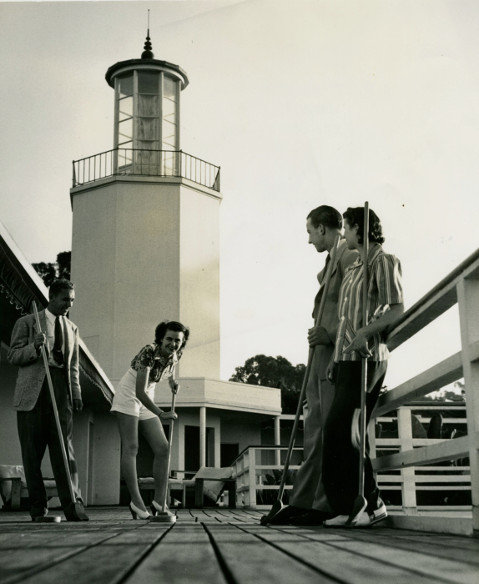The Coral Casino
A Child of the Roaring '20s

Since its opening in 1937, one of the jewels of Santa Barbara’s social scene has been the Coral Casino. Set next to the Biltmore hotel, the casino has been the venue for magnificent parties and events attended by local luminaries, European dignitaries, and Hollywood stars.
The Biltmore opened in 1927 and, after a few years of success, was in deep financial difficulty by the early 1930s. In 1936, the Pacific States Savings and Loan Company purchased the hotel. The company’s majority owner was Robert S. Odell, who brought to the hotel new ideas and major changes.

The forerunner of the Coral Casino was the Biltmore Beach Club. For a yearly fee families could rent one in a row of 40 cabanas on the beach across from the hotel. Nearby was the swimming pool, surrounded by a verdant lawn, and the two-story Biltmore Beach House, in which dances were held several times a week. Construction of the Santa Barbara breakwater in the late 1920s caused serious erosion to the beaches east of the harbor, threatening to wash away the cabanas. Odell decided to scrap the club and start afresh.
The Beach House was replaced by the Moderne-style Coral Casino, designed by San Francisco architect Gardner A. Dailey. A new pool was emplaced, one foot longer than Olympic size, reportedly Odell’s way to ensure it did not become the scene of sports events. The salt water pool and the strip of glittering white sand next to it were both heated with steam pipes. The pool was flanked by new cabanas.
Membership in the casino cost $300 in the mid-1940s, given Odell’s approval; he ruled his stretch of Channel Drive with an iron hand. Ladies had to wear dresses or skirts to events; men with haircuts that, in Odell’s eyes, were not sufficiently short were denied admittance. Employees unfortunate enough to wear inappropriate shoes or fail to chill the champagne properly could find themselves unemployed, although often hired back the very same day.
The casino became famous for the fabulous parties thrown under the watchful eye of Biltmore manager Gilbert “Icky” Outhwaite: a Hawaiian luau complete with a 60-foot waterfall attached to the diving platform, a night in Venice with gondolas bobbing in the pool, the “Blessing of the Shrimp” affair in which the pool area was transformed into a Louisiana bayou dock. In the 1950s the Music Academy of the West began holding its annual debutante ball in the casino ballroom. This necessitated replacing the room’s retractable canvas roof with a permanent one; apparently the debutantes objected to periodic soakings and dancing around milk cans placed to catch the water from the leaky roof.
Hollywood soon discovered the casino. Tyrone Power and Charles Laughton relaxed poolside while performing at the Lobero Theatre. Johnny Weissmuller and Errol Flynn both performed stunts off the diving platform, and Lana Turner was featured when Look magazine shot a photo montage at the casino. The list goes on and on, and presiding over it all was Odell, often in his private cabana engaged in one of his intense poker games.
Since Odell’s day, the casino has had a number of owners. In 2002, what architect Dailey called his “Gem of the Pacific” was designated a County Landmark.
Michael Redmon, director of research at the Santa Barbara Historical Museum, will answer your questions about Santa Barbara’s history. Write him c/o The Santa Barbara Independent, 122 West Figueroa Street, Santa Barbara, CA 93101.



